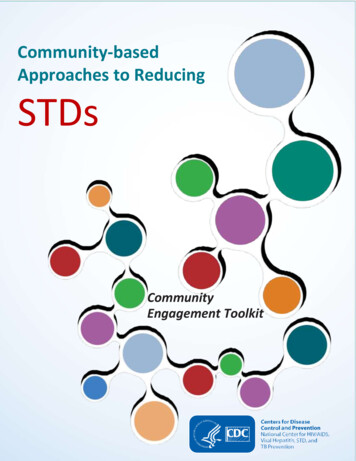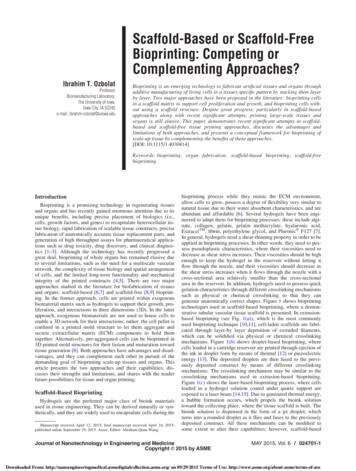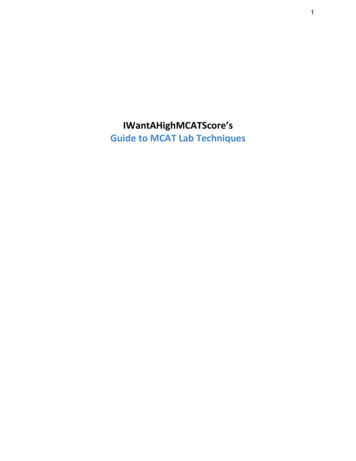
Transcription
Community-basedApproaches to ReducingSTDsCommunityEngagement Toolkit
Authors and AcknowledgmentsAuthorsShauntā S. WrightJo A. ValentineNorman A. HayesDavid B. JohnsonNixon R. ArauzAcknowledgementsGail BolanScott RhodesJason Daniel-UlloaSheena SimmonsMegan CotterLos Angeles County STD Program/ Health Research AssociationUniversity of TX Health Science Center at San AntonioUrban Affairs Coalition (UAC) YOACAPVirginia State Department of Health (Richmond City Health District)AIDS Foundation of ChicagoCity of Baltimore Department of HealthPublic Health Management CorporationUniversity of MichiganCicatelli and Associates Inc.Capacity Builders Inc.San Diego State University FoundationWake Forest University Health SciencesSuggested citationCenters for Disease Control and Prevention. Community Approaches to Reducing STDs: CommunityEngagement Toolkit. Atlanta: U.S. Department of Health and Human Services, Centers for DiseaseControl and Prevention, National Center for HIV/AIDS, Viral Hepatitis, STDs, and TB Prevention, Divisionof STD Prevention, Office of Health Equity; 2019.1
Foreword3STD Prevention:Maximizing therole of communities4How to use this toolkit7CARS Implementation Model9Conduct a Community Health Needs AssessmentEstablish a Community Advisory Board Train CAB MembersFacilitate CAB Review of Additional CHNA ComponentsEngage CAB in Social Determinant of Health PrioritizationSupport CAB STD Intervention Design Implement InterventionsEvaluate Community Engagement, Partnerships Build and Ensure Sustainability through PartnershipsCelebrate Successes with CAB and PartnersAppendix911141618202224262829
ForewordSexually Transmitted Diseases (STDs) remain one of the most critical public health challenges facing theUnited States (U.S.), with approximately 20 million new STD infections occurring every year. Nearly halfof these new infection occurs in young people ages 15-24.Centers for Disease Control and Prevention (CDC) STD surveillance data shows that there are higher ratesof reported STDs among some racial or minority populations when compared to rates among whites.Health disparities in STDs are linked to a complex blend of social determinants that influence whichpopulations are most severely affected by these diseases. Health equity entails focused efforts toimprove the health of those who experience social or economic barriers to achieving health.The Community-based Approaches to Reducing Sexually Transmitted Diseases (CARS) initiative is fundedby the Division of Sexually Transmitted Disease (STD) Prevention (DSTDP) in the National Center forHIV/AIDS, Viral Hepatitis, STD, and TB Prevention (NCHHSTP) at the Centers for Disease Control andPrevention (CDC). The program was established in 2011 to support the planning, implementation, andevaluation of innovative projects that: 1) Reduce STD disparities; 2) Promote sexual (personal) health;and 3) Advance community wellness.The CARS initiative uses community engagement methods to achieve health equity. Health equity isachieved when everyone has an equal chance to be healthy regardless of his or her race/ethnicity, sexualorientation, or social class. Learning more about the individual and social factors that sustain STDepidemics is a vital first step in assisting affected communities to improve their health status. To preventand control STDs, communities need quality health information and services.By identifying and implementing systems and environmental change strategies that promote sexual(personal) health and support healthy behaviors, the CARS initiative facilitates community-clinicallinkages to support interventions to prevent and reduce STD disparities. The program seeks to enhanceand sustain partnerships and support communication strategies that promote STD prevention activities.This toolkit was developed to make available the lessons learned from the CARS initiative toorganizations interested in implementing community engagement as a strategy, particularly for STDprevention and control.We encourage you to use this toolkit to identify and implement interventions tailored to the needs ofyour respective target communities and populations to reduce the incidence of STDs and improve theirhealth status.Sincerely,Jo Valentine, M.S.W.Associate Director for Health EquityCDC, Division of Sexually Transmitted Disease3
STD Prevention: Maximizing the Roles of CommunitiesThe current U.S. epidemic of sexually transmitted diseases (STDs) disproportionately affectsdisadvantaged ethnic and sexual minority groups. The social marginalization of persons at risk for STDscan leave these groups suspicious and distrustful of interactions with government authorities such ashealth departments, which can impede their access to much needed STD prevention and controlservices.1 In response, many STD programs are working to involve their respective focus populationsin the development and delivery of STD prevention and control interventions, thereby better informingoutreach efforts and enhancing service delivery. 2-5 However, history, especially when it’s recent, isnot soon forgotten. Sometimes the best intentions end up paving that proverbial “road” no one wantsto take.6 Yet, it does make sense to collaborate with communities and groups disproportionatelyimpacted by STDs to improve STD program effectiveness. 7 Increasingly, partnerships between healthinstitutions and the communities they serve are regarded as essential to achieving health equity.1 Butwhat does that mean?Communities burdened by STD disparities are more than the collection of statistics that describe theirhealth problems or individual risk behaviors. The meaning of community varies, and not just by censustract. The definition of community entails cultural identity and social experiences (e.g., gay men, highschool adolescents, or migratory farm workers).8 The commonly shared social determinants of healththat are unique to individual communities or groups are important to understand, as they can be eitherbarriers to or facilitators of health. Such determinants should govern the nature and scope of thecommunity engagement effort.So, what is community engagement for STD prevention and control? How can potential STD patientsbecome powerful STD prevention partners to protect the community’s health? The lessons learnedfrom the implementation of the Community-based Approaches to Reducing STDs (CARS) Projectprovide a practical roadmap to engaging with communities to prevent and control STDs.Community engagement is not only an end, but it is also a means. It is both an outcome and a dynamicprocess. Levels of engagement are likely to change based on content and context, and the personsinvolved.9 There will be times when community expertise will be more vital than professional expertise,but there will also be times when the reverse will be true. More often than not equal parts of both arenecessary. In other words, community engagement usually requires a both-and approach as opposedto either-or.As a strategy, community engagement is popular with a variety of health and social programs, andresearchers10-12. Public Health programs, in particular, increasingly rely on involving members ofunderserved, disadvantaged communities in the implementation of health promotion efforts. Studiesshow that community engagement improves intervention effectiveness and suggest that the strategyalso supports intervention sustainability.13 The traditional sudden arrival of professional experts,implementing quick—if culturally and even contextually indifferent—fixes, usually followed by abruptwithdrawals when the funds run out, often leave the targeted communities and groups frustrated andunderserved. Typically, these methods at best involve community members as staff, or in the case ofresearch, as subjects, but rarely allow for community decision-making power in the design, delivery or4
evaluation of intervention activities. A community’s only power is usually limited to the right of refusalto participate in the program or study, all too often to the community’s detriment because neededservices were not utilized. Instructed by such lessons, many Public Health programs now strive toensure that the communities they seek to serve are not merely passive consumers of services, but thatthey are also partners in health. Community engagement has become not only a strategy, but afundamental goal. To be most effective, community engagement efforts should be guided by theprinciples of authentic partnership.14Community engagement has to be pragmatic. What kind and how much community participation canthe program reasonably accommodate? One size will not fit all. Programs are obliged to set realisticobjectives for all of their partnerships. The level of community engagement is based on the degree ofcommunity- or focus-group power in relationship to the external institutions seeking to engage withthem,15 and includes careful consideration of public health laws and grant management regulations.The higher rates of STDs among some racial/ethnic and sexual minority groups are not caused byethnicity or heritage, or sexual orientation. Moreover, the risk for infection is not exclusively a functionof individual behavior. The social conditions and the community context can, and does often, play alarge role in the persistence of STDs.16 In a community with high rates of endemic STDs, sexually activepeople are more likely to acquire a sexually transmitted infection simply because they have a greaterchance of choosing a partner who is infected. Economic factors such as poverty, unemployment, andlow education levels can make it more difficult for people to stay sexually healthy. People who cannotafford basic needs and do not have health insurance, for example, can have trouble accessing qualitysexual health services; add to that a suspicion of the health care system due to the socialdiscrimination they have experienced in the health care setting, and the challenge of providingaccessible and acceptable STD testing and treatment services multiplies.Successful community engagement in public health efforts is achieved when community memberswork together in equal partnership with health and social service professionals to determine programgoals and objectives, the implementation methods, and the evaluation of outcomes. This is whatmakes community engagement a valuable strategy for the prevention and control of STDs, leading tothe reduction of STD disparities, and advancing health equity.The mission of the Division of STD Prevention is to provide national leadership, research, policydevelopment, and scientific information to help people live safer, healthier lives by the prevention ofSTDs and their complications. The CARS initiative incorporates community engagement tocollaboratively implement tailored interventions for communities and groups experiencing the highestrates of STDs. Following the CARS implementation model, individual programs have been able to workwith focus their respective focus communities and groups to design, deliver, and evaluate STDprevention and control programs, leading to improved health status for those most at risk.References1.5Valentine JA. Impact of Attitudes and Beliefs Regarding African American Sexual Behavior onSTD Prevention and Control in African American Communities: Unintended Consequences. SexTransm Dis. 2008;35(12):S23-S29.
2.3.4.5.6.7.8.9.10.11.12.13.14.15.16.6Baker EA, Wilkerson R, Brennan LK. Identifying the role of community partnerships in creatingchange to support active living. Am J Prev Med. 2012;43(5 Suppl 4):S290-299.Roussos ST, Fawcett SB. A Review of Collaborative Partnerships as a Strategy for ImprovingCommunity Health. Annu Rev Public Health. 2000;21(1):369-402.Hayes SL, Mann MK, Morgan FM, Kitcher H, Kelly MJ, Weightman AL. Collaboration betweenlocal health and local government agencies for health improvement. Cochrane Database ofSystematic Reviews. 2011(6).Brizay U, Golob L, Globerman J, et al. Community-academic partnerships in HIV-relatedresearch: a systematic literature review of theory and practice. J Int AIDS Soc.2015;18(1):19354.Gracia JN, Ruffin J. Partnership, research, and leadership to advance health equity andeliminate health disparities. Am J Public Health. 2014;104 Suppl 4:S520-521.Moseley C, Valentine J, Foust E. Lessons Learned from Syphilis Elimination in Guilford County.Health Promotion Practice. 2002;3(2):188-196.Thomas JC, Eng E, Earp JA, Ellis H. Trust and collaboration in the prevention of sexuallytransmitted diseases. Public Health Rep. 2001;116(6):540-547.Kendall E, Muenchberger H, Sunderland N, Harris M, Cowan D. Collaborative capacity buildingin complex community-based health partnerships: a model for translating knowledge intoaction. J Public Health Manag Pract. 2012;18(5):E1-13.Ramsden VR, Salsberg J, Herbert CP, Westfall JM, LeMaster J, Macaulay AC. Patient- andcommunity-oriented research: How is authentic engagement identified in grant applications?Canadian family physician Medecin de famille canadien. 2017;63(1):74-76.MacQueen KM, Bhan A, Frohlich J, Holzer J, Sugarman J, Ethics Working Group of the HIVPTN.Evaluating community engagement in global health research: the need for metrics. BMC MedEthics. 2015;16:44.Ackerman Gulaid L, Kiragu K. Lessons learnt from promising practices in communityengagement for the elimination of new HIV infections in children by 2015 and keeping theirmothers alive: summary of a desk review. J Int AIDS Soc. 2012;15 Suppl 2:17390.Barrera M, Jr., Berkel C, Castro FG. Directions for the Advancement of Culturally AdaptedPreventive Interventions: Local Adaptations, Engagement, and Sustainability. Prev Sci.2017;18(6):640-648.Auerbach S. Beyond Coffee with the Principal: Toward Leadership for Authentic School–FamilyPartnerships. Journal of School Leadership. 2010;20(6):728-757.Arnstein SR. A Ladder Of Citizen Participation. Journal of the American Institute of Planners.1969;35(4):216-224.Thomas GM. ‘It’s not that bad’: Stigma, health, and place in a post-industrial community. Health& Place. 2016;38:1-7.
How to Use This ToolkitThis toolkit provides a 10-point process for engaging communities and institutional partners in STDprevention and control. Using a detailed roadmap based on the best practices and lessons learnedfrom the Community-based Approaches to Reducing STDs (CARS) Initiative, this document is a usefultool for building effective, sustainable interventions tailored to the needs of STD-impactedcommunities or groups. This toolkit also includes a cautionary note after each of the major milestonesof the CARS Implementation Model to help readers avoid roadblocks that may occur during theprocess.Although the CARS Community Engagement Toolkit is written with a Public Health program audience inmind, the principles and practices detailed in this document are suitable to a variety of othercircumstances when community involvement in an intervention effort is desired or even essential.Most, if not all, of the CARS Implementation Model elements can work across a number of health andsocial issues. However, the examples included in this toolkit come from STD prevention and control.Engaging with communities is a dynamic process. While the CARS Implementation Model may suggesta linear action flow, it is important to remember there may be instances of back-and-forth and perhapsat times circling back, when a new information is learned, or a new partner joins an effort. Effectivelyperforming the components of the implementation model will require flexibility.For the purposes of this toolkit, we recommend you first identify which community or group you needto work with, sometimes referred to as the target population. To do this you will need to conduct acommunity health needs assessment, often called a formative assessment or formative evaluation.1,2This initial assessment is arguably the first step in the engagement process. It can be brief orcomprehensive, but the manner in which a program goes about the assessment will have important7
implications. These early interactions between a program and a community can set the tone of therelationship to come, and is seldom a one-and-done kind of activity. Programs will need to update theinformation in the assessment as they inevitably learn more.Of course, many organizations will have already completed this first activity and find themselves readyfor the next action—establishing a community advisory board (CAB) and developing initialorganizational partnerships. The toolkit describes how to recruit members for the advisory board, aswell as how to engage your CAB members. It also includes guidance for recruiting partnerorganizations.Once the CAB is established the implementation model moves to training the CAB members,followed by how to conduct an additional CAB-review of the community health needsassessment. These two actions prepare the CAB for the next milestone: social determinant ofhealth prioritization.Following the prioritization activity, the CAB should be then be ready to contribute to thedesign of the intervention. To complete this action the model calls for the sustainedengagement of the organizational partners.The seventh component addressed in the toolkit, and the obvious destination of the model, isthe CARS process for implementing a community-designed STD prevention intervention. Theimplementation of a tailored, community- or group-centric intervention is the primary purposeof the community-engagement approach.The CARS toolkit includes guidance for managing the intervention in the field, and equallyimportant provides directions for the eighth component: evaluating the intervention, includingmonitoring and measuring community member engagement and organizational partnerships.Moreover, the toolkit model offers recommendations for building and ensuring interventionsustainability, which is the ninth component of the model and one that provides a criticalindicator of success.Finally, speaking of success, this brings you to the tenth component of the CARSImplementation Model, the celebration of successes with community advisory board membersand partner organizations.You will find several tools and templates used by CARS recipients highlighted throughout the toolkit.These tools are examples of the types of templates you can use and can be tailored to feed the needsof your program and community engagement efforts. The journey begins on the next page where youwill find the first mile marker: conduct a community health needs assessment.References1. Curran GM, Bauer M, Mittman B, Pyne JM, Stetler C. Effectiveness-implementation hybriddesigns: combining elements of clinical effectiveness and implementation research to enhancepublic health impact. Med Care. 2012;50(3):217-226.2. Thomas JC, Eng E, Earp JA, Ellis H. Trust and collaboration in the prevention of sexuallytransmitted diseases. Public Health Rep. 2001;116(6):540-547.8
- - - - - - - - - - - - - - - - Conduct a Community Health Needs AssessmentThe community health needs assessment (CHNA) is a way for you to get a snapshot of localpolicy, systems and environmental change strategies.1,2 The CARS needs assessments areused to make improvements in the community, with the help of community members andpartner organizations. You can use several different data sources to conduct the needs assessment,some of which may include: STD morbidity analysis by zip codeGIS mappingCensus dataCommunity survey Town hall meetingsSTD clinical resource mappingFocus groupsPhotovoice.StepsMost community needs assessments use the following process.3-51. Plan needs assessment. This step involves selecting and convening a planning team who will decidewhat community components to assess. During this step, you will also determine data sources anddata collection methods. In addition, your planning team will decide whether to use new or existingdata sources, or a combination thereof.2. Conduct needs assessment. You should use multiple data sources, some of which are listed above,to identify where STD morbidity is highest, which specific geographical area(s) to focus your efforts,and which population will be the focus. Please see the listing of community needs assessmentresources and CHNA component checklist for more CHNA guidance.3. Review data and assess data quality. This is where you will make decisions about what data toinclude in your assessment and assess the data quality. You will revise the process to ensure that youare collecting the data that will inform decision-making.4. Analyze data. In this step, you will enter, total, and summarize the data.5. Draft an action plan. Here, you will finalize the population of interest and identify potential partnerorganizations that work with that population. The intervention components of the action plan will bedrafted later with your CAB.Cautionary NoteGetting StartedYou should be sure to use more than one data source to inform your CHNA. Some programs get overwhelmed with theamount of data and possible data sources, so you should prioritize the most relevant and reliable data sources thatreveal the disparities in your target population and identify the determinants of health. This will NOT be your onlyCHNAsince you will need to revisit this data once you convene and train your community advisory board. You will.want their feedback and reflections on this assessment, as well as their feedback on any additional assessments theymay need to make decisions about social determinants and potential interventions.9
- - - - - - - - - - - - - - - - Upon completing the initial community needs assessment, you should identify additional partners thatmay be able to help you address the issues revealed in the community needs assessment, which movesus to the next milestone: Partnership Engagement.References1.2.3.4.5.10Ainsworth D, Diaz H, Schmidtlein MC. Getting more for your money: designing communityneeds assessments to build collaboration and capacity in hospital system community benefitwork. Health Promot Pract. 2013;14(6):868-875.Akintobi TH, Lockamy E, Goodin L, et al. Processes and Outcomes of a Community-BasedParticipatory Research-Driven Health Needs Assessment: A Tool for Moving Health DisparityReporting to Evidence-Based Action. Prog Community Health Partnersh. 2018;12(1S):139-147.Goodman RM, Wandersman A, Chinman M, Imm P, Morrissey E. An ecological assessment ofcommunity-based interventions for prevention and health promotion: Approaches tomeasuring community coalitions. American Journal of Community Psychology. 1996;24(1):3361.Kirk CM, Johnson-Hakim S, Anglin A, Connelly C. Putting the Community back into CommunityHealth Needs Assessments: Maximizing Partnerships Via Community-Based ParticipatoryResearch. Prog Community Health Partnersh. 2017;11(2):167-173.Wang C, Burris MA. Photovoice: Concept, Methodology, and Use for Participatory NeedsAssessment. Health Education & Behavior. 1997;24(3):369-387.
- - - - - - - - - - - - - - - - Establish a Community Advisory Board (CAB) reflecting at-risk groupand develop initial partnershipsA major milestone in the CARS implementation model is the establishment of acommunity advisory board (CAB) that reflects the at-risk group. Creating a format or structure tofacilitate community input, contribution, and participation is essential to community engagement.These boards are comprised of individuals and stakeholders from within the community, eachproviding first-hand insight on community concerns. This unique perspective helps to understand anindividual community’s issues and underlying social determinants related to STDs in ways that are notlikely to be available through data sources alone.1-4 Below, we list key steps that CARS recipients haveused to establish their CABs and develop initial partnerships.Establish CAB1. Identify the population that you will engage for the project, based on the community healthneeds assessment. This should be the actual community members, not organizations that representor serve the community members. You should have a separate group for partner organizations.2. Identify potential partner organizations. Guided by the findings from the community health needsassessment, identify the key organizations, such as community-based organizations, healthdepartments, schools, and universities/colleges that serve the population of interest and have a stakein assisting with intervention implementation.3. Work with a community champions or organizations with good relationships with the communityof interest to identify potential CAB members. You may find your champions through partnerorganizations, word-of-mouth, or other avenues. Champions should have a good relationship withcommunity members and be able to help garner the support and energy necessary to recruit CABmembers.4. Develop an application/vetting process for accepting new CAB members. You do not want theapplication/vetting process to be so rigorous that it curtails community member participation. Youalso do not want the process to be so loose that there are no parameters to becoming and remaininga CAB member. The application process that asks the appropriate questions can lead to the selectionof CAB members with a stake in the community’s well-being, filtering out those with unwantedmotives.5. Develop and implement an onboarding process for new CAB members. This process should becomplete with a new member packet (including CAB charter, CAB contract, CAB consent form, andcontact information for staff).Your CAB does not need to be a large group, as it is difficult to manage larger groups and facilitatedecision-making processes. The average CAB membership for CARS recipients is 15 communitymembers (range of 9 to 21 community members). Because you will share decision-making power withyour CAB members, it is important for you to assess CAB member satisfaction and perceived decisionmaking power. This is discussed further in the evaluation section of the CARS implementation model.11
Next, you will need to engage potential partner organization. The table below describes the processused by CARS recipients.Develop initial partnerships1. Identify potential partner organizations. Guided by the findings from the community healthneeds assessment, identify the key organizations, such as community-based organizations, healthdepartments, schools, and universities/colleges that serve your population of interest and have astake in assisting with intervention implementation.2. Engage partner organizations that may have a high level of interest. Once you have identified alist of potential partners, you should review their mission and purpose to help determine those thatmay have a high level of interest in the project. Next, you will need to meet with those partners andgauge their level of interest in the project. Be sure to emphasize the community -based nature of theproject and that CAB members will share in decision -making regarding community interventions andsocial determinants of health (SDoH) that need to be addressed.5-83. Convene follow-up meetings with potential partner organizations and conduct a partnershipassessment. Talk with the leadership and staff of potential partnering organizations, describing yourproject’s methods and objectives, and ensuring you understand theirs. Can your organizations worktogether? Do you share common goals? Do potential partners have a good history with the focuscommunity or group? Are the potential partners vested in the health and well-being of the focuscommunity or group? If the partnerships are a go, how will the partnerships work?4. Execute agreements with each partner. Once partners have agreed to participate, you need todevelop an agreement with them. This can be a formal agreement such as a Memorandum ofAgreement (MOA), or it can be a simple partner agreement that states their commitment to assistwith the project and provide resources for community engagement efforts.There are challenges to cultivating partnerships when the intervention design has not been developed.Some partner organizations may be eager to work with the project, but may have poor infrastructure,high turnover, or poor data systems. This can be a major roadblock in the cultivation of partnerships,so be sure to manage the expectations and keep the communication open and honest. It is alsoimportant for you to distinguish the community engagement process and roles of the CAB members,program team, and partner organizations so that everyone involved has clear roles and expectations.Once you have identified the CAB and initial partner organizations, you can start training your CABmembers.Cautionary NoteDual Citizenship CommitteesIn our experience, the two groups: CAB members and the partner organization group, need to beseparate entities. This helps with autonomy and power dynamics. CARS CAB members typically have lessperceived decision-making power if organizational staff and partner organizations are members of theCAB. Some CARS recipients have had one CAB member attend meetings with partner organizations sothat partners can receive CAB updates from an actual CAB member. You may want to keep these twogroups separate to ensure shared power and bring the two groups together as needed.12
- - - - - - - - - - - - - - - - References1. Cheney AM, Abraham TH, Sullivan S, et al. Using Community Advisory Boards to BuildPartnerships and Develop Peer-Led Services for Rural Student Veterans. Prog CommunityHealth Partnersh. 2016;10(3):355-364.2. Gonzalez-Guarda RM, Jones EJ, Cohn E, Gillespie GL, Bowen F. Advancing Nursing ScienceThrough Community Advisory Boards: Working Effectively Across Diverse Communities. ANSAdv Nurs Sci. 2017;40(3):278-288.3. Israel BA, Coombe CM, Cheezum RR, et al. Community-based participatory research: a capacitybuilding approach for policy advocacy aimed at eliminating health disparities. Am J PublicHealth. 201
collaboratively implement tailored interventions for communities and groups experiencing the highest rates of STDs. Following the CARS implementation model, individual programs have been able to work . STD Prevention and Control in African American Communities: Unintended Consequences. Sex Transm Dis. 2008;35(12):S23-S29. 5 . 2. Baker EA .











